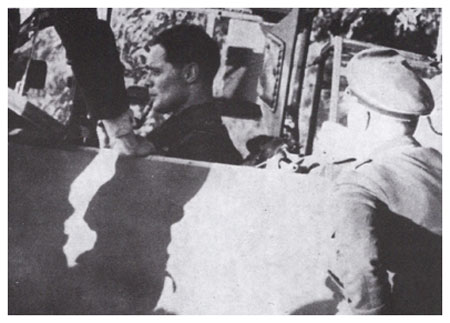| BEFORE II W.W. | II W.W.
|
AFTER II W.W. |
| UPDATED MAR 2024 | ME - CONTACT |
 |
 |
DOUGLAS BADER, THE LEGLESS PILOT |
|
Douglas Badder, was a RAF pilot before World War II, doing low altitude aerobatics crashed and lost both of the legs. With 2 prosthesis was able to walk without a stick, he was the first on earth to walk without stick and legs, he was able to play golf too, to fly, and make a standard life. Shortly before the Battle of Britain starts, he was successfully tested for pilot duties and readmitted to the RAF due to the shortage of pilots. Flying the Spitfire, crashed on take off because he had the propeller in coarse mode, he was unhurt, but the artificial legs were bent, he would have been severe injure if he had not had both prosthesis. A few days later was promoted to flight Commander of 242 Squadron of Hurricans. With an invincible and contagious spirit raised the morale of his pilots when the Battle of Britain was at its worst, he was at the newspapers headlines of the time as an example of perseverance and courage. Achieved great success despite disobeying combat tactics and often interception orders. And again, the day after an accident this time on landing its Hurrican (he run out of the runway in poor visibility), was promoted as Wing Commander, (which meant a raise from lieutenant to lieutenant colonel in a year), and he came back to fly the Spitfire at Tangmere. He was the first Wing Commander to paint their initials on the fuselage of his Spitfire DB for rapid identification, its Head of Group, Woodhall, baptize him as DogsBody, which was thereafter his call sign. It is not clear if Bader was shot down or collided with a German, according to Gallan, Bader asked who had knocked him down, he wanted to see this Ace, however in the book Reach for the Sky he tells of the crash. There is a third possibility, in the records of the Luftwaffe they only lost one plane on August the 9th, which was an accredited shoot down, there was not loses by accident in that day. In the records of the RAF there are 2 accredited kills, one in the area and time where Badder was shot down, Buck Casson relates that he saw a lone Me 109 and shoot it down, in this year of 1941 the RAF had introduced a new version of Spitfire the V¨ with a different shape, perhaps friendly fire shoot Bader down. His plane was damaged and her leg became trapped in the plane, he saved thanks to the leg was orthopedic and it was untied, letting Bader bailed out without his leg. Parachute jump with only one leg and orthopedic is not the most desirable, in the impact Douglas sank knee in the chest and was wounded several months. While still in the Hospital Adolf Galland German Hunting Chief visited him, and agreed to coordinate with the Red Cross and the RAF a secure air corridor to let someone throw him a new leg. The RAF use the information of the aisle to throw the box with the leg in a pile of bombs that damaged a Messerchimtt airfield where it was planned to released the leg. Badder before being transferred to a prison camp, escaped from the Hospital by a window tying sheets, 2 days after he was captured, he spend 3 years in several prison camps till the end of the war, he had 22 kills. (From the book "Reach for the sky" by Paul Brickhill, the amazing story of D. bader, strongly recomended) |
|
 |
Left, Douglas getting in his plane, see the initials DB Douglas Bader or DogBody |
GO TO - CLOCKS FOR SALE |
GO TOP OF THE PAGE |
HOME |